1. Brief History
Establishment of the school was originally brought upon by Tan Jiak Kim, and a group of representatives that he led, in 1904. After having raised almost $90,000, a large part of which he contributed personally, the Straits Settlements and Federated Malay States Government Medical School was founded. In 1912, the school was given a $120,000 endowment through the Edward VII Memorial Fund. This institution merged with the Raffles College, forming the University of Malaya in 1949.
Following high growth in subsequent years, the university was then re-divided into two campuses, the campus located in Singapore being titled as the University of Singapore. In 1980, this institution merged with another, the Nanyang University. By bringing these two together, the government was able to dedicate their resources to a single cause rather than dividing them.
Outstanding Alumni and Faculty Members include:
The University of Singapore, including its predecessors, has produced many notable alumni, including the following:
- Abdul Razak Hussein, Second Prime Minister of Malaysia
- Ahmed Inaz, Former Minister of Finance and Treasury of the Maldives
- Aubeck Kam, Permanent Secretary for the Ministry of Communications and Information
- Benjamin Sheares, Second President of Singapore
- Goh Chok Tong, Second Prime Minister of the Republic of Singapore
- S.R. Nathan, Former President of Singapore
- Margaret Chan, Director General of the World Health Organization
- Ng Ser Miang, Vice-President of the International Olympic Committee
- Chong Chi Tat, Former Chairman of the Asia Research Institute
- Kofi Annan, Seventh Secretary-General of the United Nations
- Richard Friend, IEE’s Faraday Medal Awardee
- Chan Heng Chee, Ambassador to the United States
- Chay Wai Chuen, High Commissioner to Sri Lanka
- Eunice Olsen, Youngest Nominated Member of Parliament, Singapore
- K. Shanmugam, Minister for Law and Foreign Affairs, Singapore
- Nguyen Thi Bich, Director-General, Ministry of Finance, Vietnam
- S Jayakumar, Former Deputy Prime Minister and Coordinating Minister for National Security
- Noeleen Heyezer, United Nations Under-Secretary-General, Head of UNIFEM

2. Key Facts
Established:
1905
Type:
Public
Structure:
The University spans three campuses within Singapore: Kent Ridge, Bukit Timah and Outram. The University consists of 16 Faculties and Schools:
- Arts and Social Sciences
- Business
- Computing
- Dentistry
- Design and Environment
- Engineering
- Law
- Medicine
- Music
- Science
- University Scholars Program
- Yale-NUS College
- Duke-NUS Graduate Medical School Singapore
- Lee Kuan Yew School of Public Policy
- NUS Graduate School for Integrative Sciences and Engineering
- Saw Swee Hock School of Public Health
In addition, there are seven overseas campuses. They are situated in China (Shanghai and Beijing), Israel, India, Sweden (Stockholm) and the United States (Silicon Valley, Bio Valley and New York). There are three additional teaching centers within the National University of Singapore. These include the Centre for Development of Teaching & Learning, the Centre for English Language Communication, and the Institute of Systems Science.
Staff:
NUS staff comprises 2,314 Faculty Members, 2,999 Research Staff, 2,493 Executive and Professional Staff, and 2,391 General Staff.
Students:
37,452 – Undergraduates make up 27,391 of this total and graduate students account for 10,061. These students come from 100 countries.
Endowment:
US $1.179 billion


3. Research
The National University of Singapore has 3 Research Centers of Excellence as well as 24 university-level research centers and institutes. In addition, they have affiliation with 16 research institutes and centers that are at the national level.
For a full list of their university-level research centers and institutes, please check:
www.nus.edu.sg/dpr/research/university
And their research centers of excellence:
www.nus.edu.sg/dpr/research/centre
The University is especially known for its research in the following areas:
- Engineering
- Life sciences & Biomedicine
- Social & Natural sciences
Funding programs and Outstanding Researcher Awards stimulate and reward quality research at the University.
4. Partnerships and Programs
In addition to the opportunities that students may participate in through the University’s Overseas Colleges, student exchanges are available all over the world. Their Undergraduate Student Exchange Program allows students to spend time abroad, at one of more than 40 countries, receiving credit toward their degree. Over 1000 of these placements are prepared for students annually. Exchanges are completed in the following countries:
- Australia
- China, Hong Kong, Taiwan
- Japan
- New Zealand
- South Korea
- Canada
- Mexico
- United States of America
- Australia
- Belgium
- Croatia
- Denmark
- Estonia
- Finland
- France
- Germany
- Hungary
- Ireland
- Israel
- Latvia
- Lithuania
- Netherlands
- Norway
- Poland
- Romania
- South Africa
- Spain
- Sweden
- Switzerland
- Turkey
- United Kingdom
iLEAD, which stands for innovative Local Enterprise Achiever Development, is a program which places students in local Singaporean entrepreneurial positions. A similar program, entitled the NUS Overseas Colleges (NOC) program, students intern abroad while complementing their experience with academic studies.
Affiliations:
The National University of Singapore is affiliated with 16 research institutes and centers that are at the national level. They are part of the Association of Pacific Rim Universities (APRU) and International Alliance of Research Universities (IARU), which are international networks. Other affiliations include Universitas 21, GEM4, AUN, ASAIHL and NUS High School of Mathematics and Science.
5. Trivia
Motto:
Towards a Global Knowledge Enterprise

Miscellaneous:
According to the Times Higher Education World University Rankings, the University of Singapore places 26th in the world for the 2013-2014 year. Their rankings deem the University as the 2nd best in Asia for the same year.
